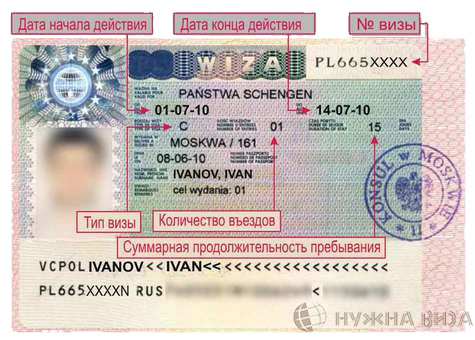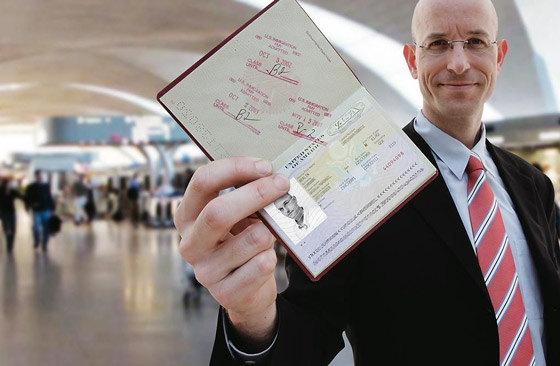What types of visas are: classification and generally accepted designations
In most cases, to visit another state, you will need to obtain special permission from the authorities. A formal confirmation of such permission is a visa issued by the relevant embassy. This practice was introduced after the Second World War as a means of controlling the movements of foreign citizens. If at the beginning visas had a rather fragmented character in terms of registration and differed only in terms of entry and exit, now they have already undergone significant changes. They became not only obligatory for visiting many states, but also began to be divided into categories.
Different types of visas determine not only the fact of obtaining permission to visit the country, but also the purpose of the visit, restrictions on the length of stay, restrictions on the subject of permitted activities and the import and export of funds and goods. You can get a visa at the embassy of the state where the trip is planned, and as quickly as the internal rules of the embassies stipulate.
A visa is not required only if relevant agreements have been concluded between the countries, for example, residents of countries that have signed the Schengen agreement can freely carry out any movement between the parties to the agreement without the need for visas. For everyone else, entry into the Schengen zone is allowed on the general rules stipulated by the Schengen agreement.
In every country in the world, visas are categorized or marked with alphanumeric markings and are designed for a specific type of visit. For example, there are three types that are issued for work: H-1B, H-2A, H-2B.
At the moment, all types of permits can be divided into two main groups: short-term and long-term. Each of these groups is further refined by several more subcategories. Short term may be:
- Tourist;
- Guestbook;
- Business;
- transit.
Long-term are divided into:
- Guestbook;
- Working;
- Student;
- For family reunification or moving to permanent residence (immigration).
In addition, the type may vary depending on the status of the recipient, so they distinguish: a simple visa, official and diplomatic.

- A - airport;
- B - transit;
- C - tourist;
- D - national.
Already on the basis of these types, details are indicated by a numerical code, for example D-14 is a long-term national visa for study.
Valid term of a visa. Single entry and multiple entry visas
Any visa is issued with a limited validity period and gives the right to stay in the country only for a certain time. The method of visiting can be additionally negotiated. So almost all types of visas can be single and multiple (multivisas). With single visits, everything is extremely simple, they are designed for a one-time visit. Having left the country even ahead of time, it is no longer possible to cross the border again without issuing a new visa. Multiple entry visas only limit the total time of stay and do not prevent regular border crossings. Most often, the multi mark is placed on the document itself.
When calculating the time of stay in a country with a visa regime, the entire time period from the moment of crossing the border upon arrival to the actual departure is taken into account. In the Schengen area, the countdown of the time of stay begins after crossing the first border of any participating country, and the departure is registered accordingly.
Short Term Visas
Short-term visas are all types of visas that are issued with permission to visit the country for a period of 1 to 90 days. These include transit, tourist, guest and business visas. Sometimes an extension of the period is possible, and it is required either to contact the immigration service or visit one of the border checkpoints to obtain the appropriate mark in the foreign passport. However, more often, under the condition of issuing a short-term visa, the visitor is obliged to leave the territory of the state no later than the agreed time.
Tourist
The most common type of visas designed to visit the country as a tourist, vacation or visiting places or events of interest. It is subject to a number of restrictions. With a tourist visa in hand, you cannot be hired or start training, conduct research or scientific activities that may affect the interests of the visited country or if such activities require separate permits. Actually prohibited any activity other than tourism. Restrictions are imposed on the import and export of money or certain goods. All conditions can be clarified at the consulate upon receipt or their information sources. Such visas are issued more often for a period of stay from 15 to 90 days, rarely more. Most likely, in the process of obtaining, you will need to indicate the exact route, stops, exact time of arrival and departure from the country of destination.
In the case of the European Union, the types of Schengen visas for tourism are classified as category "C". Subcategories from 1 to 4 indicate the period of possible stay in the Schengen area:
- C1 for a period not exceeding 30 days;
- C2 for a period of 31-90 days;
- C3 multivisa with a total stay of up to 90 days;
- C4 multi for 90 days and valid for up to 5 years.
For the United States, a regular tourist visa has the designation B-2.
Guestbook
The process of obtaining a visa can be greatly simplified if there is an invitation from a resident of the country where the trip is planned, and it will already be classified as a guest trip. Such a short-stay visa allows you to visit many countries without the necessary formalities, such as booking hotel rooms or specifying the exact route.
![]()
It is important to take into account all the necessary formalities required by the consulate for an invitation, if required by the visa procedure. Visitor visas in different countries can have many subcategories, depending on the inviting person and the conditions of the guest's stay.
Business
A business visa implies visiting the country in order to negotiate or conclude contracts, search for new partners, etc. Such permits are issued either to legal entities or official representatives of firms or companies. In this case, you should receive an invitation from the host, that is, from the companies with which you plan to meet, or an official letter from the relevant authorities, such as the Chamber of Commerce, indicating the applicant's field of activity.
You can visit Schengen for business negotiations both with a category C visa and the corresponding type, and with category D, if the activity is limited to only one of the countries of the Schengen agreement.
Even if it comes to a state that actually prohibits tourist visits or has strict registration rules, obtaining a business visa is quite simple, especially if the visitor's field of activity is in line with domestic and foreign policies.
transit
To visit many parts of the world, it is required to additionally cross the territory of third countries. This may be a brief refueling stop for an aircraft, or it may be a ground transportation route through the territory of a third country between the point of departure and the purpose of the trip. Some countries allow foreign nationals to be on the territory of an airport or other buffer zone without any additional formalities during such stops or routes. And yet, in addition to obtaining a visa to the country of destination, it will often be necessary to take care of obtaining transit visas of countries whose borders are to be crossed along the way. The process of obtaining is extremely simple and often consists of informing the missions about the transit. They are issued upon the availability of permission to visit the target state and supporting documents of the route.
Long stay visas
All long-term visas are permits for stays of more than 91 days, up to several years. You can get a long-term visa only with sufficient justification for the purpose of the visit and if they do not contradict the established rules. As an example, we can single out guest visas for visiting relatives for a long period, work visas, permissions for studying at schools, colleges, universities.
Guestbook
A long-term visitor visa most often involves visiting relatives or close acquaintances for up to several years. This requires an invitation and, if necessary, sufficient justification and confirmation of family ties between the inviting party and the invitee.
In the Schengen zone, a visa of type D can act as a long-term guest visa. It confirms permission to visit a single country in the Schengen zone, therefore it is also defined as a national one. In most cases, it still allows you to visit other Schengen countries, while only one important rule remains - the country of first entry into the Schengen zone with such a visa must be exactly the one for which it was issued.
working
For the official registration of hired labor abroad, you must obtain a work visa. Such a visa is a permit to stay for the entire duration of the employment contract or agreement. It doesn't matter whether it is attracting a highly qualified professional or a seasonal handyman, to obtain such a visa, an invitation is required from the company in which the invitee intends to work. Only if you intend to look for a job, you should provide a letter from the local chamber of commerce or proof of career guidance and experience that are in demand in the target region.

Work visas are almost always distinguished by the nature of employment. For example, in the case of the Schengen area, they can fall into three main categories, regarding the rules:
- D-15 - issued for professional activities or for work in demanded positions;
- D-07 - seasonal work in agriculture.
In other countries, work visas may differ, given the current situation in the labor market.
Student
To study at foreign universities, students and students are issued a student or study visa, which allows them to stay in the country for the entire period of study and, in some cases, as with a multivisa, repeatedly cross the border. To receive, supporting documents must be submitted indicating that the educational institution is ready to accept a foreign student. The validity of a visa may cover the entire period of study or only part of it, for example, one semester. In the second case, it will be necessary to constantly renew the permit, provided that there are no claims from the university to the student.
Along with study visas, you can also get a guest visa, designed to accompany the student with his parents or visit him while he is studying.
Family reunification and resettlement
A separate type of visa in many countries is a permit for family reunification. The conditions for obtaining such a visa vary significantly from state to state and depend on the characteristics of the mentality, customs and even religion. It makes it possible to stay with relatives for a long time, up to several years, or to be the starting point for family members to obtain a single citizenship.
To obtain such a visa, it is necessary to substantiate the relationship and confirm the desire of the host party to accommodate and possibly support the applicant.
Other types of visas
In addition to such visas as tourist, work or visitor visas, there are additional subcategories that arise from the need to clearly limit the rules of stay in the country or indicate the special status of the visit.
Visa for marriage. Bride's visa
International marriages require a special approach. One of the main goals of such unions is to obtain a single citizenship for all family members. In order to ensure the conditions for obtaining citizenship by the bride or groom, a permit is issued, that is, a visa for marriage. The permission is more often called the bride's visa, because much more often it is the bride who moves to the groom and must subsequently receive a new citizenship. Such a visa is often much more difficult to obtain than a simple guest visa; in addition to the invitation, convincing evidence of a close relationship between the future spouses should be presented, excluding the option of a fictitious marriage. This situation has developed with the process of obtaining a K1 visa for the United States.

On the other hand, in some countries, for example, obtaining a visa number 300 (marriage visa) is somewhat easier, because this country is loyal to international marriages and supports such unions. At the same time, it is difficult for an Australian citizen (citizen), because you will need to prove your financial viability in order to maintain your soulmate for two years.
Journalistic
To carry out journalistic activities in other countries, it is also necessary to obtain an appropriate visa. In the USA, category “I” is issued to media representatives with strict conditions for conducting journalistic activities and reporting information. In addition to the United States, a journalist visa will be required when traveling to Cuba, Iran, North Korea, the Kingdom of Saudi Arabia and Zimbabwe. In most other states, the entry of media representatives can be carried out according to a simplified scheme or even as in a visa-free regime.
Official and diplomatic
The hotel category of visas is provided for representatives of countries and organizations that have official and diplomatic passports. In such cases, the process of issuing permits is carried out at the level of the relevant authorities.
Visas for the purpose of research and scientific activities
Almost all countries that have a visa regime have separate categories of permits for those wishing to conduct research or scientific activities on the territory of the state. Most often, such visas are obtained through a simplified procedure. For example, in South Korea, a visa for researchers and researchers can be issued within a few hours online through the embassy portal.
Anyway before submitting documents for registration, you must clearly indicate the reason for visiting a country with a visa regime, because it is on the basis of the application that the consulate will decide on the choice of the appropriate type of visa. Along with obtaining the necessary permission, it is worth further clarifying all the nuances regarding the restrictions and requirements in force in the target country for visitors. This applies to the issues of import and export of money, goods, objects, and even behavior that is acceptable according to customs and mentality. Violation of the visa regime may result in a ban on re-visiting.




